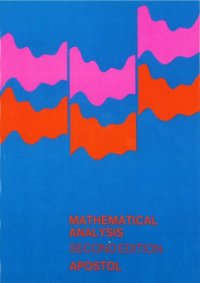
Ebook: Mathematical Analysis: A Modern Approach to Advanced Calculus
Author: Tom M. Apostol
- Genre: Mathematics
- Tags: Mathematical Analysis Advanced Calculus
- Year: 1973
- Publisher: Pearson
- City: Pasadena
- Language: English
- pdf
This is a very carefully written introduction to real analysis. When Apostol published the first edition in 1957, he intended it to be intermediate between calculus and real variables theory, and it still has a strong feeling of being a transitional course. It starts out with several chapters on the number line and point set topology, then proves all the basic facts that are taken for granted in differential calculus courses. It then proceeds into what is new material for most students, with two new theories of integration (Riemann-Stieltjes and Lebesgue), multivariable and vector calculus (focusing on existence theorems such as the Implicit Function Theorem rather than physical applications), some advanced theorems in sequences and series, approximation by sequences of functions and orthonormal bases, and a brief introduction to complex variables.
The book crams a lot of material into a modest number of pages, though without feeling rushed. This is done primarily by sticking to the main threads of the subject in the exposition, while moving a lot of related and more specialized results to the exercises. The proofs themselves are not overly brief, although there’s not much handholding and only a few examples are given, so (a) you have to pay attention, and (b) it’s very helpful to have already taken advanced calculus so that you can orient yourself. In many ways this book resembles the British analysis books of the early twentieth century, such as Hardy’s A Course of Pure Mathematics and Titchmarsh’s Theory of Functions. The approach is generally more modern, and there are many more exercises, but it has the same kind of concision.
The book makes a good balance between simplicity and generality. For example, the Riemann-Stieltjes integral rather than the plain Riemann integral is used for the elementary integration (before Lebesgue). It’s not any harder, introduces some other valuable concepts such as functions of bounded variation, and gives us a tool which is often useful in discrete and discontinuous problems. For another example, Fourier series are developed first for orthogonal systems and then specialized for trigonometric series. Again, this is not any harder and gives us a better insight into why Fourier series work.
Rudin’s Principles of Mathematical Analysis is the one to beat in this field. Apostol’s treatment is not that different from Rudin’s. The books were written about the same time, with Rudin having editions in 1953, 1964, and 1976, and Apostol in 1957 and 1974. The coverage of the two books is roughly similar. Rudin is slightly more abstract and slanted more toward multivariable analysis. Both have concise proofs, a shortage of examples, and numerous challenging exercises. Both cover the Riemann-Stieltjes integral rather than the plain Riemann integral. Both cover the Lebesgue integral, although Rudin is more skimpy and uses the conventional measure theory approach, while Apostol follows Riesz & Sz.-Nagy et al., using a functional-analysis approach through step functions.
Apostol has taken care to modularize his book, so that it can be used for several different courses and the material studied in different orders. Rudin’s treatment is more tightly integrated. This often makes Apostol easier to use as a reference, because everything you need to understand a theorem will be close by.
The book crams a lot of material into a modest number of pages, though without feeling rushed. This is done primarily by sticking to the main threads of the subject in the exposition, while moving a lot of related and more specialized results to the exercises. The proofs themselves are not overly brief, although there’s not much handholding and only a few examples are given, so (a) you have to pay attention, and (b) it’s very helpful to have already taken advanced calculus so that you can orient yourself. In many ways this book resembles the British analysis books of the early twentieth century, such as Hardy’s A Course of Pure Mathematics and Titchmarsh’s Theory of Functions. The approach is generally more modern, and there are many more exercises, but it has the same kind of concision.
The book makes a good balance between simplicity and generality. For example, the Riemann-Stieltjes integral rather than the plain Riemann integral is used for the elementary integration (before Lebesgue). It’s not any harder, introduces some other valuable concepts such as functions of bounded variation, and gives us a tool which is often useful in discrete and discontinuous problems. For another example, Fourier series are developed first for orthogonal systems and then specialized for trigonometric series. Again, this is not any harder and gives us a better insight into why Fourier series work.
Rudin’s Principles of Mathematical Analysis is the one to beat in this field. Apostol’s treatment is not that different from Rudin’s. The books were written about the same time, with Rudin having editions in 1953, 1964, and 1976, and Apostol in 1957 and 1974. The coverage of the two books is roughly similar. Rudin is slightly more abstract and slanted more toward multivariable analysis. Both have concise proofs, a shortage of examples, and numerous challenging exercises. Both cover the Riemann-Stieltjes integral rather than the plain Riemann integral. Both cover the Lebesgue integral, although Rudin is more skimpy and uses the conventional measure theory approach, while Apostol follows Riesz & Sz.-Nagy et al., using a functional-analysis approach through step functions.
Apostol has taken care to modularize his book, so that it can be used for several different courses and the material studied in different orders. Rudin’s treatment is more tightly integrated. This often makes Apostol easier to use as a reference, because everything you need to understand a theorem will be close by.
Download the book Mathematical Analysis: A Modern Approach to Advanced Calculus for free or read online
Continue reading on any device:

Last viewed books
Related books
{related-news}
Comments (0)